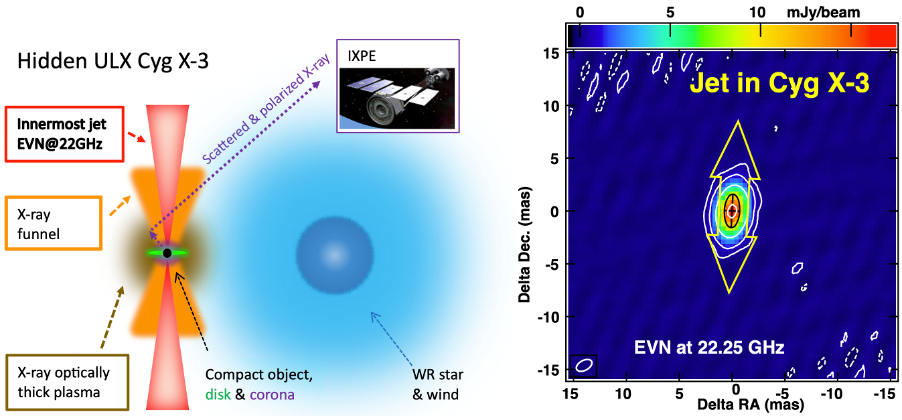
Uncovering the innermost jet in the hidden ultra-luminous X-ray source Cygnus X-3
Jun Yang
As a Galactic high-mass X-ray binary, Cyg X-3 hosts a compact object accreting matter from a Wolf-Rayet star. X-ray polarization observations show that Cyg X-3 is most likely a hidden ultra-luminous X-ray (ULX) source with a luminosity above the Eddington limit along the direction of an optically thin X-ray funnel. The latest EVN observations of Cyg X-3 at 22 GHz reveal an elongated jet structure in the quiescent radio state for the first time. More interestingly, the jet position angle is fully consistent with the X-ray tunnel direction, indicating that the radio jet propagates along and within the X-ray funnel. The finding provides an unprecedented view of the complex central engines of ULXs.

Cyg X-3 was discovered more than five decades ago. In the binary system, the compact object is likely a black hole. Recently, Cyg X-3 has been recognized by Veledina et al. (2023) as a hidden Galactic ULX source with the IXPE (Imaging X-ray Polarimetry Explorer) observations. The X-ray emission of Cyg X-3 shows a very high (about 25 %) linear polarization and a relatively low apparent luminosity because of strong Thomson scattering along the line of sight. If there exists an optically thin X-ray funnel (Veledina et al. 2023), its origin would be tightly related to potential innermost jet activity. The proposed inner structure of Cyg X-3 is shown in the left panel.
The innermost jet of Cyg X-3 is shown in the right panel. The EVN map was observed with seven European telescopes. Thanks to 4-Gbps data rate and a very high observing frequency of 22 GHz, the pilot EVN experiment successfully minimized the negative effect of scatter broadening. Based on the simultaneous X-ray observations with the space telescope NICER, Cyg X-3 was found in the quiescent radio state. In the EVN map, the jet direction is consistent with the direction of the optically thin X-ray funnel. This supports that the radio jet propagates roughly along the central axis of the X-ray funnel. Moreover, the jet is marginally resolved in the transverse direction, possibly because of the strong stellar winds and the rapid orbital motion.
References:
Veledina, A. et al., 2023, arXiv e-prints, p. arXiv:2303.01174
More information:
Published in Yang et al. 2023, MNRAS, 526, L1-L7
https://doi.org/10.1093/mnrasl/slad111
Contact:
Jun Yang
Onsala Space Observatory, Sweden
Email: jun.yang@chalmers.se